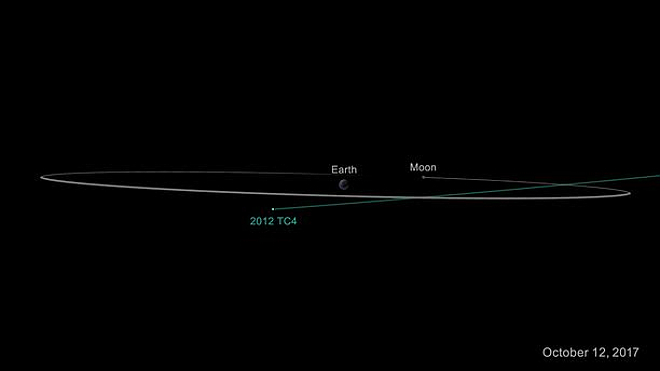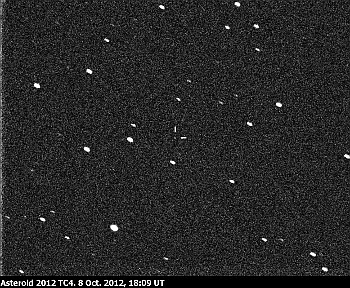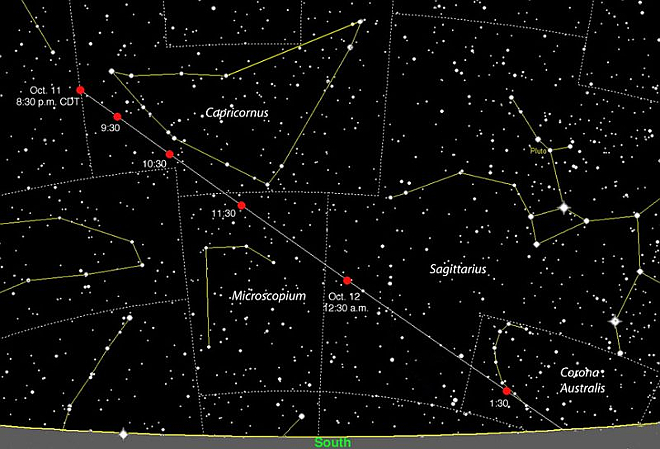 |
| Illustration of a possible orbit for asteroid 2012 TC4, via NASA. |
EarthSky.org
 |
| Image of asteroid 2012 TC4 (center) from 2012, via G. Masi and F. Nocentini/ Virtual Telescope Project. |
Last summer, experts were already saying they knew the rock wouldn’t hit us, but they thought 2012 TC4 might give us a close shave, passing as close as 4,200 miles. In late July, though, astronomers recovered the space rock – picked it up telescopically again, after not seeing it for some years – and the new observations let them refine their knowledge of 2012 TC4’s orbit and better compute its closest distance to Earth later this month. Thus we now know the object will pass around 30,000 miles above Earth’s surface.
2012 TC4 will come closest to Earth at around 10:42 a.m. October 12. It’ll come close enough that Earth’s gravity will slightly alter the asteroid’s path. Later in the day on October 12 – at 12:19 p.m., the asteroid will pass some 172,000 miles from the moon.
The asteroid is currently travelling at a speed of about 30,000 mph, and while it appears very dim at the moment, it’ll get brighter as it gets closer.
Can you see asteroid 2012 TC4 as it sweeps past? Not with the eye alone, surely.
But experienced observers with telescopes and charting software will be able to pick it up, and you can watch online as the asteroid passes. The Virtual Telescope Project in Italy will offer two online observing sessions, on October 11 and 12, in cooperation with Tenagra Observatories in Arizona. Click here to go to Virtual Telescope’s observing page for 2012 TC4. https://www.virtualtelescope.eu/webtv/
Experienced backyard observers have a shot at the asteroid, too. To see it, you’ll need to make your own tracking map using sky charting software. AstroBob has instructions on how to do that at his blog. He wrote:
"Observers in the Americas (especially South America) will get the best views as 2012 TC4 hurtles from Capricornus across Microscopium and into southern Sagittarius during early evening hours. [The locator map below], with stars to magnitude 8, shows the asteroid’s trajectory across the evening sky on the evening of October 11. Positions are shown every hour starting at 6:30 p.m. PDT. 2012 TC4 will be much fainter, around magnitude 13."
 |
| Chart showing the path across our sky of asteroid 2012 TC4, created with Chris Marriott’s SkyMap, via AstroBob. |
Find instructions for how to create your tracking map on AstroBob’s October 3 blog post.
Meanwhile, CNEOS is working with astronomers of the International Asteroid Warning Network on a plan to utilize asteroid 2012 TC4 in an exercise to test NASA’s network for planetary defense against asteroids. They’ve said they intend to test out their ability to recover, characterize and report on a potentially hazardous object approaching Earth.
Recover, in this sense, doesn’t mean recovering a sample from an asteroid; it means recovering the object via telescopes as it moves across the heavens, using tracking data from an earlier pass.
The calculations on the October, 2017, pass of asteroid 2012 TC4, for example, were originally based on only seven days of tracking it, shortly after it was discovered in 2012. Then we lost the object again, in the depths of space, as it sped away from us.
That’s an exceedingly common scenario for close-passing asteroids, which are, after all, just flying chunks (some more like flying mountains) of rock in space. They sweep past then go their way.
These astronomers are trying out their planetary defense systems – a global protection against asteroids on a possible collision course with Earth – which they’ve been discussing for decades and developing over the last few years.
Brightness measurements made during the week it was observed in 2012 gave an estimated size of 30 to 100 feet for asteroid 2012 TC4. That’s comparable to the meteor that caused a shock wave and explosion in Earth’s atmosphere, over the Russian city of Chelyabinsk, in February 2013, injuring 1,500 people and damaging over 7,000 buildings.
The Chelyabinsk meteor, before it struck Earth’s atmosphere, is estimated to have been about 20 meters wide.
Astronomers also know that 2012 TC4 is an elongated and rapidly rotating asteroid. And they know that asteroid 2012 TC4 has made many close approaches to Earth in the past.
Bottom line: A small asteroid designated 2012 TC4 will pass Earth safely – but closely – on October 12, 2017. Experts are certain it won’t hit Earth. This summer, an international collaboration of telescopes is trying to reacquire the asteroid – that is, find it again in space – with the goal of precisely determining its orbit.
To learn more, click here.